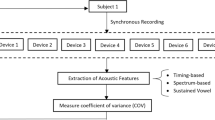Abstract
This paper presents a study of kurtosis analysis for the sound /x/ in male speech, /x/ is the sound of the ‘o’ at the end of words such as ‘ago’. The sound analysed for this paper came from the Australian National Database of Spoken Language, more specifically the male speaker 17. The /x/ was isolated and extracted from the database by the author in a quiet booth using standard multimedia software. A 5 millisecond window was used for the analysis as it was shown previously by the author to be the most appropriate size for speech phoneme analysis. The significance of the research presented here is shown in the results where a majority of coefficients had a platykurtic (kurtosis between 0 and 3) value as opposed to the previously held leptokurtic (kurtosis > 3) belief.
Similar content being viewed by others
References
Cassidy, S. and Harrington, J.,The place of articulation distinction in voiced oral stops: Evidence for burst and formant transitions, Phonetic, 52: 263–284, 1995.
Liberman, A. M., Harris, K. S, Hoffman, H. S. and Griffith, B. C.,The discrimination of speech sounds within and across phoneme boundaries, Journal of Experimental Psychology, 54(5): 358–368, 1957.
Stubbs, R. J. and Summerfield, Q.,Evaluation of two voiceseparation algorithms using normal-hearing and impairedhearing listeners, Journal of the Acoustical Society of America, 84(4): 1236–1249, 1988.
Le Blanc, J. P. and De Leon, P. L.,Speech separation by kurtosis maximization, Proceedings of IEEE International Conference on Acoustics, Speech and Signal Processing, 1998.
Deller, J. R., Jr., Hansen, J. H. L. and Proakis, J. G.,Discretetime processing of speech signals, 2nd ed., Wiley Interscience IEEE Press, 2000.
Rabiner, L. R. and Schafer, R. W.,Digital Processing of Speech Signals, 1st ed., Prentice Hall, 1978.
Denbigh, P. N. and Luo, H. Y.,An algorithm for separating overlapping voices, IEE Colloquium on Techniques for Speech Processing and their Application, 9: 1–6, 1994.
De Leon, P. L. and Ma, Y.,Blind Separation of L Sources from M Mixtures of Speech Signals, Proceedings of the 140th Meeting of the Acoustical Society of America, Newport Beach, CA., 2000.
De Leon, P. L. and Ma, Y.,Normalized, HOS-Based, Blind Speech Separation Algorithms, Proceedings of the 34th Asilomar Conference on Signals, Systems and Computers, 2000.
Ding, Z. and Li, Y.,Blind Equalization and Identification, vol. 9, 1st ed., Marcel Dekker, 2001.
Kendall, M. G. and Stuart, A.,Distribution Theory, vol. 1, 6th ed., Edward Arnold, 1998.
Dorman, M. F., Studdert-Kennedy, M. and Raphael, L. J.,Stop-consonant recognition: Release bursts and formant transitions as functionality equivalent, context dependent cues, Perception & Psychophysics, 22(2): 109–122, 1977.
Stubbs, R. J. and Summerfield, Q.,Algorithms for separating the speech of interfering talkers: Evaluations with voiced sentences, and normal-hearing and hearing-impaired listeners, Journal of the Acoustical Society of America, 87(1): 359–372, 1990.
Tokuda, K., Kobayashi, T. and Imai, S.,Adaptive cepstral analysis of speech, IEEE Transactions on Speech and Audio Processing, 3(6): 481–489, 1995.
Flanagan, J. L.,Speech Analysis Synthesis and Perception, 2nd ed., Springer-Verlag, 1972.
Bulmer, M. G.,Principles of statistics, 1st ed., Oliver & Boyd, 1965.
Brehm, H.,Description and Generation of Spherically Invariant Speech Model Signals, Signal Processing, 12: 119–141, 1987.
Millar, J. B., Vonwiller, J. P., Harrington, Jonathan, M. and Dermody, P. J.,The Australian National Database of Spoken Language, Proceedings of IEEE International Conference on Acoustics, Speech, and Signal Processing, Adelaide, South Australia, 1994.
Author information
Authors and Affiliations
Corresponding author
Rights and permissions
About this article
Cite this article
Orr, M.C., Lithgow, B. Higher order statistical analysis of /x/ in male speech. Australas. Phys. Eng. Sci. Med. 28, 56 (2005). https://doi.org/10.1007/BF03178865
Received:
Accepted:
DOI: https://doi.org/10.1007/BF03178865




